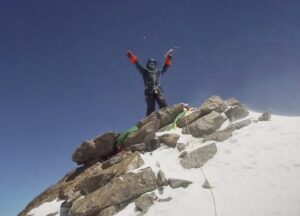There is much more to high-altitude climbing than marching in line up a fixed rope until the altimeter passes 8,000m and the queue stops for a selfie. But then, the 8,000’ers, especially the popular ones, have evolved into a different sport.
Those looking for wild and lonely peaks, self-sufficient climbing and old-fashioned adventure still have endless possibilities in Pakistan, without having to invest a fortune. These Karakorum and near-Karakorum experiences include some areas recently opened to climbing. Permit fees are modest, and climbers have many opportunities for first ascents or new routes.
They only have to look for a summit lower than 8,000m, yet high enough for the challenges of thin air, technical lines, and extreme conditions. Of course, the flip side is the increased difficulty and dwindling chances of success. Shorn of logistics, Sherpa rope fixers, and technology, climbers have no money-back guarantees to complete their dream climb.
This season in the Karakorum is a good example: Few teams attempting new routes or first ascents on Pakistan’s 6,000’ers and 7,000’ers fulfilled their goals; or at least, not completely.
Nevertheless, they have given us genuine climbing stories and reminded us that purity of style and beauty is everything, while 8,000 is just a number.
Below, a summary of those expeditions:
Muchu Chhish
Muchu Chhish is the highest unclimbed mountain open to alpinists, authorities of prominence notwithstanding. A Czech team launched two attempts on this difficult peak. On the first, an excess of fresh snow forced them back from above Camp 3. On the second, after hours of slogging up to their waists in what they colorfully called “sugar crystal disgusting snow matter”, Pavel Korinek and Tomas Petrecek had to retreat back from 6,600m. Still, they came back with some amazing footage.

The Czech team’s Camp 3 under a 20m ice cliff on Muchu Chhish. Photo: Czech Expedition
Pumari Chhish East
Tom Livingstone and Mathieu Maynadier managed to “almost” climb Pumari Chhish East (6,850m). They retreated just 100m below the summit in hellish weather and survived an epic descent amid avalanches. Despite falling a little short, they did spectacularly well in difficult conditions and, especially since they had not climbed together before. Next year, the new partners will return to pursue their original goal: the main summit of Pumari Chhish.
Damsan Peak
There were successes too: Chamonix guides Martin Elias, Jerome Sullivan, Victor Saucede, and Jeremy Stagnetto climbed an aesthetic, direct new route up Damsan Peak (aka K13) in the Kondus Valley. They climbed the Western Point (6,600m): 1,600m of technical climbing up to M6, 6.
As they left, a Finnish team led by Juho Knuuttila went for the North Face. High temperatures turned the snow into slush and eventually pushed them back. The heat also caused constant rockfall, and the hazard from falling seracs increased dramatically.
Similar warm weather frustrated a Hungarian team on Laila Peak.

A member of the French team on steep, snowy Diram Peak. Photo: Helias Millerioux
Diram Peak
Yet the elite team of Yannick Graziani, Patrick Wagnon, and Helias Millerioux achieved perhaps the most lauded success of the season. On July 11, the trio reached the top of Diran Peak (7,260m), after three days of climbing its North Ridge alpine style. No doubt we will read about them in a few weeks when the Piolet d’Or jury announces this year’s finalists. Whether they will compete with Simon Messner and Martin Sieberer remains to be seen. The duo was also climbing in Pakistan, but they have not made their goals or results public.






